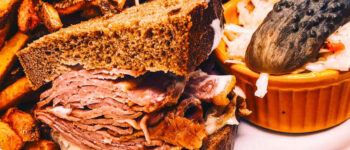Being able to differentiate between fresh and spoiled cheese is vital if you’re eating cheese as part of your diet. Since each type of cheese varies in appearance and texture, it can be challenging to determine if it’s still safe to eat. So, how to tell if cheese is bad? Find out by reading this article.
How to Tell If Cheese Has Gone Bad
Generally, you’ll want to pay attention to the following characteristics: expiration date, appearance, smell, and texture. We explain more in detail below.
Another thing to keep in mind is that soft cheeses can spoil sooner than hard cheeses. Furthermore, cheeses in their natural form (a.k.a. unprocessed cheese) have shorter shelf lives than their processed counterparts with preservatives and artificial ingredients.
Expiration date
Like other dairy products, you will find the label “best by date” on cheese, which indicates when cheese has the best quality and flavor. According to the USDA, this has nothing to do with the product’s safety [*].
For this reason, it’s fine to eat unopened cheese past its printed date especially when stored in the fridge. As for opened cheese, soft varieties (cream cheese, blue cheese, mozzarella cheese) can last up to 7 days in the fridge while hard varieties (cheddar, gouda, colby, shredded) can last up to 4 weeks since they contain less moisture.
To be on the safe side, always check the best by or expiration date and do not eat cheese past this date.
Appearance of the cheese
How do you know when cheese is bad based on its appearance? Visual cues are a good indicator, such as cheese developing a different color — for instance, a hard cheese like cheddar or parmesan turning dark.
If you notice blue or green mold on the surface of a hard cheese, try cutting away that moldy part. You should be able to safely eat the parts without the mold. Be careful when removing the mold to avoid contaminating the rest of the cheese with the knife you use.
Soft cheeses, on the other hand, are a different story. If they have visible mold, throw away the entire cheese. The same goes for shredded and sliced cheeses.
Smell of the cheese
If cheese smells bad with ammonia-like or sour odor, then it may be a good idea to throw it out. Unless you’re very familiar with the smell of fresh cheese, regardless of the type, make sure to smell it when you first open the packaging. This will help you recall its original smell and identify spoiled cheese later on.
Texture of the cheese
Last but not least is the texture. In addition to a darker color, the appearance of mold, and ammonia-like odor, spoiled cheese can develop a different texture. If it feels different when you slice it now compared to last week — e.g. it feels crumbly, mushy, or very dry — there’s a huge chance it has already gone bad.
How to Make Cheese Last Longer
If you love eating cheese, knowing the best ways to store it is key to maximizing its shelf life. Storing hard cheese is going to be a bit different than storing soft cheese due to issues with the cheese drying out. This is especially true if you’ve purchased a huge chunk of cheese and you’re not able to consume everything anytime soon.
Follow these tips to keep cheese fresh:
- Wrap remaining soft cheeses in cheese paper (a waxy paper) to protect them while also allowing them to breathe. This also gives the cheese some air to prevent excessive moisture since soft cheeses have a higher moisture content.
- However, if you’re planning to consume soft cheese within days, then it’s fine to keep it in its original plastic wrap.
- As for hard cheeses, wrap them tightly in cheese paper or parchment paper or a sealed container (plastic wrap or glass) if you’ll eat them within a few days.
- When it comes to freezing, hard cheeses like cheddar and parmesan can be kept in the freezer as long they’re placed in a ziplock bag. On the contrary, soft cheeses like brie and ricotta, as well as processed cheeses like spreads, are unsuitable for freezing.
- For the best quality avoid storing cheese together with other items that could impart other odors and flavors.
FAQs
See more : How Long Does Sauerkraut Last?
Discover more facts about keeping cheese fresh:
What happens if you eat bad cheese?
Cheese may provide a ton of benefits, but it doesn’t matter if you’re eating spoiled cheese. Bad cheese could lead to food poisoning, with symptoms such as stomach pain, diarrhea, vomiting, and fever. Contact your healthcare provider immediately if you experience these symptoms.
How long does cheese last in the fridge?
If opened, hard cheeses can last in the fridge for up to 4 weeks while soft cheese can last only 7 days. In addition, remember to store your cheese properly in cheese paper and make a habit of checking for signs of spoilage.
Why does cheese spoil so fast?
This is usually because cheese (fresh cheese) doesn’t contain preservatives and colorings. In contrast, processed cheese can last longer especially when you handle it properly.
The Bottom Line
If cheese smells bad, is way past its expiration date, has mold growing on it (soft cheeses in particular), and develops a different texture — it’s not fit for consumption. Overall, cheese is best eaten when it’s fresh and stored in the right conditions.
Worried about cheese going bad? Interested in cheese products that are shelf-stable and nutritious? At Käze, we produce different types of cheese bites using a special drying technology that extends their shelf life.
Enjoy quality cheese snacks for months whether you’re traveling, going to the gym, having a picnic, or simply watching movies at home.
Nigel Gildon editor:Nigel Gildon is the editor of Chef Wayne’s Big Mamou: Chef Wayne’s Big Mamou. He has worked in the publishing industry for many years and has a passion for helping new authors get their work into the hands of readers. 63 Liberty Street * Springfield, MA 01003




